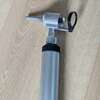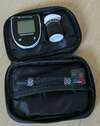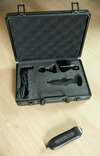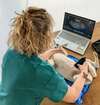These days, general veterinarians have a whole range of instruments to carry out an exhaustive clinical examination of your pet and investigate any symptoms it may be displaying.
What about home vets? Is it possible to combine comfort and quality?

1. The base: the bag
Like SOS doctor, I have my bag, in which I store all the small instruments I need for the basic clinical examination.
Easy to carry, it allows me to get right up to your front door, even if you live on the 5th floor without an elevator (in that case, let me know anyway, so I can get my sneakers on!). It's complete, so you don't have to go back and forth to the car, and you can examine your dog or cat from snout to tip of tail.
2. Essential tools
Instruments such as stethoscopes, otoscopes and ophthalmoscopes are easy to carry in the bag.
The stethoscope allows you to check your companion's heart and lungs.
The otoscope allows you to examine your auditory canal, i.e. the inside of your ear. Thanks to this instrument, I can detect an otitis, the presence of a spikelet (a small grass that creeps in wherever it can in summer) and, more rarely, a mass (such as a polyp).
The ophthalmoscope is used to evaluate your dog's or cat's eye. It allows me to detect cataracts, lens stenosis (normal aging of the lens) or corneal wounds (ulcers).



3. SCALES
An essential tool for monitoring your pet's weight, the scale is an indispensable part of the basic clinical examination. Has your dog/cat gained or lost weight? This information is essential, not only for aesthetic reasons, but also to assess your pet's good health or, on the contrary, the unfavorable evolution of a pre-existing disease.
It's easy to imagine the vet arriving with his cat scale under his arm, but what about larger cats? Well, there are portable scales for those too! Your Labrador can have his weight curve too, rest assured!



4. Tensiometer
It is used in special cases, when hypertension or conversely hypotension is suspected.
When the animal appears particularly tired or pale, a drop in blood pressure may indicate haemorrhage or shock (exceptional cases).
More frequently, blood pressure measurement is part of the regular monitoring of an older animal or one suffering from kidney disease, heart problems, hyperthyroidism...
5. Glucose meter
It instantly measures blood sugar levels. It is used when hypoglycemia is suspected, as well as in cases of diabetes mellitus.
All it requires is a tiny drop of blood in the ear, so it can be easily performed at the patient's bedside.


6. Blood analyzer
For senior animals and those who appear ill, measuring certain blood parameters is essential for diagnosing certain pathologies.
I have a portable analyzer, which I carry in a case. An electrical plug, a few milliliters of blood and seven minutes of patience are all it takes to get results at home, without stress or waiting time.
7. Ultrasound scanner
Engineers are constantly improving imaging instruments, and have developed what are known as "ultra-portable" ultrasound scanners. A little jewel of technology, they are the size of a cell phone and fit into a blouse pocket.
The ultrasound is performed on a table in your own home, with your companion cradled in a cushion adapted to his or her morphology.
It allows me to assess the appearance of the various organs, the presence of fluid or a mass, and to collect urine directly from the bladder...


8. The microscope
This one is a must-have in dermatology. Otitis? It's essential to know which germs are involved, in order to select the right treatment and duration. A scratch wound that won't heal? Check that it's not infected, so you can put your dog or cat on antibiotics if necessary.
I also use it for urinary disorders, to assess the presence of bacteria (sign of urinary infection) or urinary crystals (typical in cats).
It can also be transported in a case and plugged into the mains. Unfortunately I don't have any photos, as it is still being delivered at the time of writing......
As you may have guessed, much of the technology found in conventional veterinary clinics fits into a simple car! Nowadays, home vets are able to bring all the technology right to your door.
(many thanks to my long-time collaborator, my Jack Russel dog Harpie, for her help in writing this article)

